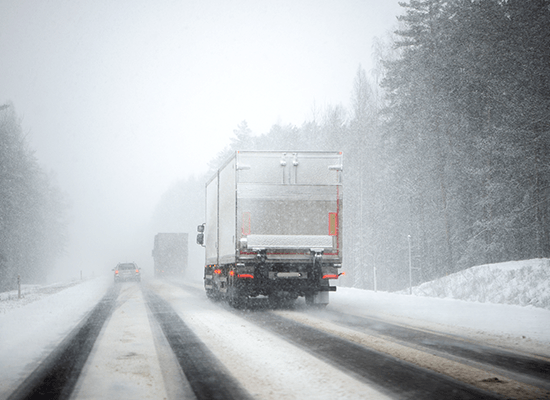- 1603 Capitol Ave. Ste. 310, Cheyenne, WY, 82001
- +1 (307) 222 4897
- info@acetruckingservices.com

The US trucking business goes through a variety of changes over the winter. It's crucial to have your truck ready for winter, especially if you plan to travel through northern regions where icy weather, subfreezing temperatures, snow, and sleet are frequent occurrences. No matter where you are, it's critical that you comprehend how winter affects freight transportation across the nation and how you can deal with the situation. Driving a truck carrying heavy machinery and equipment can be difficult even on average days, even for experienced drivers, so significant snow and ice storms can be risky for truck drivers to venture into in order to deliver their loads from place to place.
According to the Federal Highway Administration of the US Department of Transportation, snowy or icy roads account for roughly 25 percent of weather-related vehicle crashes. Truck drivers who do not use safe trucking practices during the icy winter months run the risk of hydroplaning and skidding due to the freezing temperatures and strong winds.


Our daily lives are fueled by the 3.5 million truck drivers in America. Each Class 8 truck driver logs about 63,000 miles a year to transport the vital resources our communities require to survive, including food, products, building supplies, and life-saving medical supplies. However, although serving a vital purpose, the majority of drivers are still exposed and helpless in the face of a constant danger: the sudden change of weather in the US.
The weather, after all, is an unpredictable factor that can alter at any time. Truck drivers frequently travel in changing, frequently unforeseen weather conditions, which can be hazardous due to both the event itself and how other drivers react. It's crucial to keep preserving fleet operations when driving in bad weather as we enter the core of a chilly winter.
Trucking in winter carries a number of risks, and knowing that the road conditions are hazardous makes all truck drivers more alert and cautious. Reduced visibility, slick roads, snow drifts, and unpredictable fellow drivers are a few of these concerns. Truck drivers need to recognize when they can push through difficult driving conditions and when they need to stop. Drivers who decide to travel amid inclement weather endanger not just their own lives but also the lives of other truck drivers.
A number of risks can arise in winter for drivers, especially truck drivers. It's essential to spot potential problems before giving your truckers winter driving advice so they'll be ready for anything. Here are several challenges that truck drivers should be ready for when carrying throughout the winter:
Temperatures below zero: The riskiest part of truck driving throughout the winter is arguably the icy weather. The cold compounds any problems the truck already has, which can result in drained batteries, subpar performance, rough idling, and a larger possibility of a breakdown.
Snow and ice: Another hazard to be aware of is black ice especially if you are driving in snow for the first time. The invisibility makes it particularly dangerous. The road appears to be clear, making it highly dangerous to accelerate, turn, and brake. Snow can exacerbate visibility problems and increase the risk that ice poses.
Equipment failure: Despite not only occurring in the winter but equipment failure can also be made worse by extremely low temperatures and poor visibility. If you don't already have them prepared, it will be difficult to request assistance or obtain any parts or tools.
The unpredictability of the weather: Even in the most favorable conditions, the weather remains unpredictable. However, the winter might increase the hazards by directing a blizzard toward the transportation route. Because of the decreased visibility, the roads may become even more hazardous.
These pointers will assist truck drivers in getting ready for the winter in the US and will ensure that they are driving as safely as possible.
Be cautious about checking the weather for your route before you go on any journey. Even if the weather may be pleasant where you are right now, a full snowstorm can be just a few hours away. Plan your route and prepare for the weather at each stop along the way. To decide if you'll be traveling when terrible weather starts, consider how much time you'll be spending at each stop, so be sure of your route and schedule.
Always be ready for the hardships that cold weather may offer. In the event that you become trapped or stuck in subfreezing weather, make sure to have an emergency kit. Blankets, extra layers of clothes, a flashlight, wholesome food that will keep you going, water, windshield washer fluid, an ice scraper, jumper cables, traction mats, and at least half a tank of gas should always be in your car. When traveling during a winter storm, always have a strategy in place for what to do if you encounter this kind of issue.
Whether it's sub-freezing temperatures or not, you should inspect your truck before any travel. This is especially crucial for your safety in the winter. You might need to make a small adjustment to your normal vehicle inspections throughout the winter.
You should examine your tires for wear, pressure, and balance, as well as your battery's power and charging system, wiper blades for functionality, and whether or not they are covered in snow or ice. Check topped-off fluid levels and fully working lights. Make sure the exhaust pipe is free of snow, and check the defrosters to make sure they are working.
Sudden, abrupt movements can make you lose control since traction is decreased by forceful acceleration and braking. Keep your speed constant and steady, and apply the brakes lightly. Keep a safe braking distance in ice circumstances by keeping a spacing between you and the car in front. If the weather condition is adverse or uncontrollable, stay where you are. Make contact with your supervisors and let them know what is happening so that the delivery can be rescheduled.
Drivers fail to adjust their speed to the circumstances of the road in the majority of collisions. You might need to slow down while driving on a snow-covered road to make up for the lack of traction. Additionally, moving slowly will give you more time to respond in case something goes wrong.
The stopping distance is almost ten times longer on icy roads and twice as long on rainy ones. Avoid driving around a number of cars. Avoid trailing too closely. You are too close if the vehicle's tail lights are visible in front of you particularly if it is snowing. If you are following too closely behind the person in front of you and they suddenly come to a stop, you can rear-end them. In fact, maintaining a safe distance from other drivers while driving in icy conditions helps to prevent accidents.
Tire spray, the kick-up of rocks, salt, snow, and other road dirt, can result from wet pavements. By adding mud flaps to semi-trucks, truckers may help prevent tire spray. Mud flaps not only protect the undercarriage from damage, but they also lessen the amount of debris that is sprayed onto the vehicles that are following behind them.
While it may be appealing to drive as quickly as possible to avoid being stuck in the snow for too long, doing so can result in speeding citations or accidents. Drivers of tractor-trailers must slow down in order to gain traction. The trailer may attempt to stop while still moving if the brakes are applied forcefully.
Mostly, truckers in the US have to face the challenge of fog and snow accumulation on the windscreen when driving in the snow. Indeed, the best solution is to run your defroster for a while. Any remaining snow will melt owing to the defroster's heat, making windscreen cleaning simple.
Truckers should have the proper equipment with them while leaving because wintertime issues like cold wind, fog, and snow are typical. You should be aware as a truck driver that any water in the fuel or air tank will quickly freeze and clog the fuel pickup, making it difficult for you to drive. Timely inspect the gasoline lines, fuel tank, and air system.
To maintain extra weight on the tires for optimum drive traction, keep the tank full. Having strong lug tires and adequate fuel to weigh down the tires is also advised when driving in the snow. Additionally, having adequate fuel will spare you the headache in the event that there are no nearby refill stations.
When it is cold outside, visibility is very limited. Therefore, remember to turn on your truck's headlights. The other drivers will be able to see you and keep a safe distance from your truck as a result of this.
With both hands on the steering wheel, unwind and concentrate on driving. Pull over if necessary, but always remember to slow down, announce your movements with your blinkers, be aware of tire spray, regain traction, and turn your lights on so other cars can see you.
While waiting for better road conditions is never ideal, it is often the only option. During snow or ice storms, roads may close, leaving you stranded whether you want to be or not. Don't end up risking your life or harming your goods.
All professional truck drivers must possess a certain set of skills in order to perform well in challenging winter driving conditions. When driving in bad weather, especially on snow- or ice-covered roads, you must modify your driving technique and follow winter weather driving tips. In bad weather, having good handling and skid control skills is crucial. The ability to drive safely and effectively in hazardous conditions can really set professional drivers apart from the rest of the field. Keep your essentials with you, stay calm and be mentally prepared for the challenges.
Your email address will not be published. Required fields are marked*
Copyright 2022 ACETRUCKING.